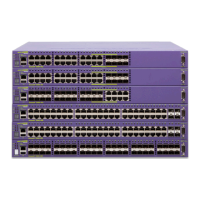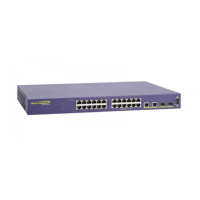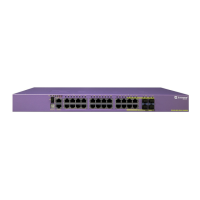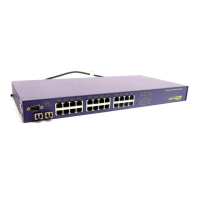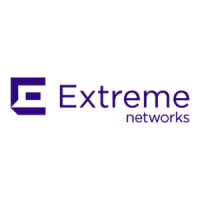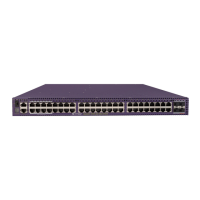Do you have a question about the Extreme Networks Summit 200-24 and is the answer not in the manual?
Details the physical characteristics of the Summit 200-24 switch.
Details the physical characteristics of the Summit 200-48 switch.
Highlights safety precautions before installing or removing switch components.
Details the process of mounting the switch in a rack or placing it free-standing.
Provides steps for initial login and IP configuration.
Lists the supported ExtremeWare features for the Summit 200 series switch.
Lists the default settings for ExtremeWare features on the switch.
Explains how to enter commands and the required privilege levels.
Covers user and administrator levels for switch management.
Details user-level access, administrator accounts, and default accounts.
Lists methods for managing the switch: console, Telnet, SSH2, and SNMP.
Explains how to use Telnet for remote switch management.
Describes SSH2 for encrypted Telnet sessions and its enabling process.
Details SNMP parameters like trap receivers and community strings.
Covers user authentication methods: RADIUS client and TACACS+.
Details configuring RADIUS servers for authentication and accounting.
Explains the configuration of TACACS+ for authentication, authorization, and accounting.
Describes controlling user access via authentication on a per-port/VLAN basis.
Details commands to enable or disable individual or multiple switch ports.
Explains how to manually configure port speed and duplex settings.
Describes how to increase bandwidth and resiliency using port groups.
Defines VLANs and their benefits for network administration.
Explains VLAN tagging (802.1Q) and its benefits for spanning switches and multiple VLANs.
Steps to create and configure VLANs, including IP addresses and ports.
Explains mapping ports to VLANs based on source MAC addresses.
Explains the switch's MAC address database for frame forwarding decisions.
Details commands for configuring FDB entries, including aging time and types.
Introduces access policies for forwarding and route decisions, security, and QoS.
Describes using access control lists for packet filtering and forwarding.
Covers policies for controlling routing protocol advertisement and recognition.
Lists commands used to configure access control lists.
Guides on creating, configuring, and applying access profiles for routing.
Explains NAT's function of converting private IP addresses to public IP addresses.
Guides on configuring VLANs as inside, outside, or none for NAT.
Details commands for configuring NAT translation rules.
Provides examples for creating different types of NAT rules.
Explains EAPS for fast protection switching in Ethernet ring topologies.
Lists and describes EAPS configuration and monitoring commands.
Introduces policy-based QoS for specifying service levels for traffic.
Discusses QoS requirements for common applications like voice and video.
Details commands to configure QoS profiles for ports and VLANs.
Explains traffic classification into groups based on common attributes.
Explains traffic marking using 802.1p priority and DiffServ code points.
Guides on using the QoS monitor for verifying configuration and performance.
Provides information about the switch's status for technical support.
Details viewing port statistic information like link status and packet counts.
Explains how the switch logs configuration and fault information.
Lists commands for configuring, resetting, and clearing logs.
Explains STP as a bridge mechanism for fault tolerance and loop prevention.
Describes partitioning the switch into virtual bridges called Spanning Tree Domains.
Guides on creating, enabling, and configuring STP domains and parameters.
Explains layer 3 IP unicast routing using RIP or OSPF.
Steps to configure IP unicast routing, including VLANs, IP addresses, and protocols.
Guides on configuring OSPF, including setting router IDs and areas.
Explains IGMP snooping for constraining multicast traffic and optimizing bandwidth.
Provides critical safety warnings for installation, maintenance, and operation.
Details power requirements, grounding, and outlet specifications.
Lists physical, environmental, power, and safety specifications for the 200-24 switch.
Lists physical, environmental, power, and safety specifications for the 200-48 switch.
Guides on upgrading switch software using TFTP.
Troubleshooting guide for LED status issues like power or link lights.
Provides steps for resolving issues when the switch does not power up.
Provides contact information for technical support via phone, email, and website.
Details the physical characteristics of the Summit 200-24 switch.
Details the physical characteristics of the Summit 200-48 switch.
Highlights safety precautions before installing or removing switch components.
Details the process of mounting the switch in a rack or placing it free-standing.
Provides steps for initial login and IP configuration.
Lists the supported ExtremeWare features for the Summit 200 series switch.
Lists the default settings for ExtremeWare features on the switch.
Explains how to enter commands and the required privilege levels.
Covers user and administrator levels for switch management.
Details user-level access, administrator accounts, and default accounts.
Lists methods for managing the switch: console, Telnet, SSH2, and SNMP.
Explains how to use Telnet for remote switch management.
Describes SSH2 for encrypted Telnet sessions and its enabling process.
Details SNMP parameters like trap receivers and community strings.
Covers user authentication methods: RADIUS client and TACACS+.
Details configuring RADIUS servers for authentication and accounting.
Explains the configuration of TACACS+ for authentication, authorization, and accounting.
Describes controlling user access via authentication on a per-port/VLAN basis.
Details commands to enable or disable individual or multiple switch ports.
Explains how to manually configure port speed and duplex settings.
Describes how to increase bandwidth and resiliency using port groups.
Defines VLANs and their benefits for network administration.
Explains VLAN tagging (802.1Q) and its benefits for spanning switches and multiple VLANs.
Steps to create and configure VLANs, including IP addresses and ports.
Explains mapping ports to VLANs based on source MAC addresses.
Explains the switch's MAC address database for frame forwarding decisions.
Details commands for configuring FDB entries, including aging time and types.
Introduces access policies for forwarding and route decisions, security, and QoS.
Describes using access control lists for packet filtering and forwarding.
Covers policies for controlling routing protocol advertisement and recognition.
Lists commands used to configure access control lists.
Guides on creating, configuring, and applying access profiles for routing.
Explains NAT's function of converting private IP addresses to public IP addresses.
Guides on configuring VLANs as inside, outside, or none for NAT.
Details commands for configuring NAT translation rules.
Provides examples for creating different types of NAT rules.
Explains EAPS for fast protection switching in Ethernet ring topologies.
Lists and describes EAPS configuration and monitoring commands.
Introduces policy-based QoS for specifying service levels for traffic.
Discusses QoS requirements for common applications like voice and video.
Details commands to configure QoS profiles for ports and VLANs.
Explains traffic classification into groups based on common attributes.
Explains traffic marking using 802.1p priority and DiffServ code points.
Guides on using the QoS monitor for verifying configuration and performance.
Provides information about the switch's status for technical support.
Details viewing port statistic information like link status and packet counts.
Explains how the switch logs configuration and fault information.
Lists commands for configuring, resetting, and clearing logs.
Explains STP as a bridge mechanism for fault tolerance and loop prevention.
Describes partitioning the switch into virtual bridges called Spanning Tree Domains.
Guides on creating, enabling, and configuring STP domains and parameters.
Explains layer 3 IP unicast routing using RIP or OSPF.
Steps to configure IP unicast routing, including VLANs, IP addresses, and protocols.
Guides on configuring OSPF, including setting router IDs and areas.
Explains IGMP snooping for constraining multicast traffic and optimizing bandwidth.
Provides critical safety warnings for installation, maintenance, and operation.
Details power requirements, grounding, and outlet specifications.
Lists physical, environmental, power, and safety specifications for the 200-24 switch.
Lists physical, environmental, power, and safety specifications for the 200-48 switch.
Guides on upgrading switch software using TFTP.
Troubleshooting guide for LED status issues like power or link lights.
Provides steps for resolving issues when the switch does not power up.
Provides contact information for technical support via phone, email, and website.
| Model | Summit 200-24 |
|---|---|
| Power over Ethernet (PoE) | No |
| Power Consumption | 30 W |
| VLANs Supported | 256 |
| Jumbo Frame Support | Yes |
| Power Supply | Internal AC |
| Type | Managed |
| Ports | 24 |
| Uplink Ports | 2 |
| MAC Address Table Size | 8K entries |
